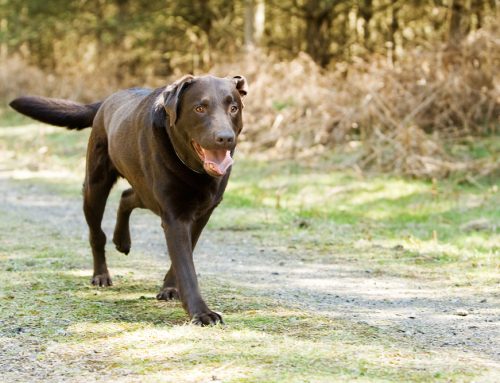If your four-legged friend is limping, you are understandably concerned. Dogs can limp for numerous reasons, some more serious than others, and our Boca Midtowne Animal Hospital team often evaluates canine patients for lameness. Here, we provide information about common dog limping causes and how these conditions are addressed.
How do I tell which limb my limping dog favors?
In some cases, your furry pal makes determining the affected limb easy by refusing to bear weight on that leg and holding the paw off the ground, but in other instances, you may only notice a slight change in gait. Determine the limb your dog is favoring with these pointers:
- Front limb lameness — If your dog has a front limb lameness, they will raise their head when the affected leg is on the ground and lower their head when the good leg is on the ground.
- Hind limb lameness — If your dog has a hind limb lameness, they will typically shift their weight to their front end, and their hip will rise when the affected limb is on the ground.
When your dog is affected in multiple limbs, you may not see an obvious limp. Potential signs in these instances include decreased interest in play, stiffness after resting, difficulty navigating stairs, reluctance or inability to jump on or off elevated surfaces, and awkward resting postures.
Why do dogs limp?
Your dog will limp because of many conditions that most commonly include:
- Osteoarthritis (OA) — OA, which is common in dogs, especially senior dogs, causes chronic cartilage degeneration that creates inflammation and pain in and around the joint. Contributing factors include increased age, injury, genetics, excess weight, and developmental issues.
- Broken toenail — A toenail may have broken or been torn off completely while your dog was playing or running, which can be extremely painful if the sensitive quick is exposed. The injury may also bleed extensively. A broken or torn toenail is not a life-threatening emergency, but you should seek veterinary attention as soon as possible to alleviate your pet’s pain and prevent infection.
- Cranial cruciate ligament (CCL) injury — The CCL is an important supporting structure in your dog’s knee, and injury to this tissue is one of the most common causes of canine hind end lameness. Young, athletic dogs can traumatize their CCL when playing, but the condition can also affect older dogs as the structure degenerates over months or years. Breeds at increased risk for CCL injury include rottweilers, Newfoundlands, Saint Bernards, Mastiffs, and Labrador retrievers.
- Developmental orthopedic diseases — Conditions, such as hip and elbow dysplasia, osteochondrosis dissecans of the shoulder, and hypertrophic osteodystrophy, often cause lameness in dogs, especially large- and giant-breed dogs. Contributing factors include genetics, rapid growth, inappropriate nutrition and, potentially, spaying or neutering too early.
- Fractured bone — Trauma from being hit by a car, falling from an elevated height, or sports injuries can lead to a broken bone, causing lameness.
- Tick-borne illness — Tick-borne illnesses, such as Lyme disease and Rocky Mountain spotted fever, can lead to joint inflammation and a shifting limb lameness.
- Bone cancer — Osteosarcoma or other cancers involving your dog’s limbs often cause a chronic or intermittent lameness.
- Paw injury — A paw laceration or foreign body can make walking difficult. You may notice your dog licking their paw incessantly, in addition to favoring the limb.
- Intervertebral disc disease (IVDD) — IVDD can aggravate the nerves innervating the limbs, causing lameness or limb weakness.
When is dog limping an emergency?
If your dog is favoring a limb, but otherwise eating and acting normally, you can schedule a regular appointment with our Boca Midtowne Animal Hospital. Signs your canine friend needs immediate veterinary care include:
- Extreme pain, such as vocalizing and trembling
- Behavior changes, including hiding, unwillingness to move, inappetence, and aggression
- Bleeding
- Obvious fracture or dislocation
- Limb dragging
- Large swellings
- Other signs, such as fever, lethargy, vomiting, disorientation, and trouble breathing
How is dog limping diagnosed?
Diagnostics to determine why your furry pal is limping may include:
- History — Our team takes a thorough history to determine when your dog started limping and the circumstances, including if your dog has previously demonstrated a similar issue.
- Physical examination — We evaluate your dog from nose to tail, including taking their temperature, palpating and manipulating their limbs, and observing their gait.
- X-rays — In many cases, we may recommend X-rays to better evaluate your dog’s bones and surrounding structures.
- Blood work — Our team may perform a complete blood count and biochemistry profile to evaluate your dog’s overall health, and to ensure medications we may prescribe are safe for your furry pal.
- Ultrasound — In some cases, we may use an ultrasound to better visualize relevant structures.
How is dog limping treated?

Your dog’s treatment will depend on their lameness cause, but likely will include:
- Rest — In some cases, a few days’ rest may allow your dog’s injury to heal and resolve the lameness.
- Pain medications — Prescription pain medications may help alleviate your dog’s inflammation and discomfort.
- Joint supplements — If your dog has OA or conditions that may lead to OA, we may recommend joint supplements, such as chondroitin, glucosamine, and omega-3 fatty acids.
- Weight management — Maintaining a lean body weight will benefit your pet who has a chronic orthopedic condition, such as OA, hip dysplasia, CCL injury, and elbow dysplasia, and we may recommend a diet change or weight-loss program.
- Environmental management — Dogs with chronic conditions can benefit from home changes, and we may suggest that you provide stairs or ramps to elevated resting spots, ensure they can easily access to food and water bowls, and provide supportive, comfortable bedding.
- Rehabilitation exercises — We address many orthopedic conditions with controlled rehabilitation exercises that can strengthen muscles and help increase mobility.
- Surgery — In some cases, surgery is the best option to get your furry pal back to their normal activity level.
If your dog is limping, contact our Boca Midtowne Animal Hospital team, so we can get them back on all four limbs as soon as possible.








Leave A Comment